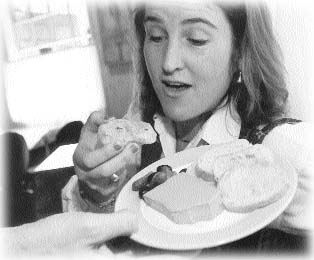![[MetroActive Dining]](/gifs/dining468.gif)
![[MetroActive Dining]](/gifs/dining468.gif)
[ Dining Index | Sonoma Independent | MetroActive Central | Archives ]
Liver Let Die
Duck Duck Goose: Samantha Williams, server at Babette's Restaurant, pronounces foie gras "orgasmic."
Foie gras enthusiasts say paté takes the cake
By David Templeton
GUILLERMO GONZALES first tasted foie gras at the start of a yearlong stay in France. Full of entrepreneurial notions of starting his own foie gras farm in America, Gonzales--a native of in El Salvador--had gone to France to study, working side by side with the duck farmers who produce the rare centuries-old European delicacy--a dish that gourmet chefs routinely call "The Food of the Gods." Gonzales' first taste, he is amused to report, was far from heavenly.
"I didn't like it," he confesses with a laugh. "You have to develop your palate. Like learning to appreciate a fine wine or any other delicacy, foie gras is an acquired taste."
Fortunately for Gonzales, it is a taste he soon acquired, and in 1986 he and his wife relocated to Northern California, purchasing a small ranch outside the town of Sonoma, where they promptly founded Sonoma Foie Gras.
The Gonzales' company is the one and only American competitor to the larger Hudson Valley Foie Gras company in upstate New York. In over a decade of playing David to Hudson Valley's Goliath, Gonzales has watched demand for his product increase slowly but steadily. Once only a seasonal Christmas and New Year kind of dish, foie gras is now being offered year-round by a legion of fine local restaurants, eagerly devoured by gourmands who have definitely acquired their own tastes.
Affirming that most of his requests come during the holidays, Oliver's Market meat manager Daren Huddlestun has watched demand for the grand comestible grow at his Cotati store, resulting in a year-round availability of foie gras paté in the deli and his current stock of fresh foie gras at the meat counter.
Pronounced fwah grah, and literally meaning "fat liver," foie gras is the oversized liver of a duck; goose was the traditional foie gras bird, but since demand for duck meat is higher than for that of goose, duck is now commonly used. Expensive, running from $38 to $50 per pound, foie gras is the primary ingredient in pricey patés and some terrine dishes, and can also be sautéed, roasted, steamed, salt-cured, or grilled.
Usually eaten spread upon toast sweetened with unsalted butter in paté form, foie gras is extremely high in fat. In fact, foie gras is almost nothing but fat, inspiring some of its fans to maintain strict diets for weeks in advance of a special dinner. The average duck liver weighs about a pound and a half, is a pale luminescent color, and has a slightly sweet, peculiarly intense flavor that is difficult to characterize. Most foie gras fans find it easier to describe it in terms of its mouth-feel than its taste.
"Texture is a very important component of foie gras," agrees Daniel Patterson, head chef at Babette's Restaurant & Wine Bar in downtown Sonoma, as he displays an elegant platter of foie gras paté. "The flavor is really wrapped up in the texture. It's got a tough cellular structure, so it's very creamy." Babette's uses only Gonzales' locally raised foie gras, also serving dishes using the magret (breast meat) of the Sonoma ducks, which are a pure Muscovy variety.
"The Sonoma County livers tend to be very custardy," Patterson continues, and when pressed to name another food to compare to the flavor of foie gras, he is at a loss. "What do oysters taste like?" he shrugs. "Foie gras tastes like foie gras."
ON THE OTHER SIDE of the spectrum from those debating how to describe the flavor of foie gras are those who see the whole industry as being in bad taste, period.
In recent months, the ethics of duck liver production have been challenged by various animal rights groups, who specifically cite gavage, the force-feeding process of the birds by which the livers gain their distinctive size. Seeking a ban on American-raised foie gras, People for the Ethical Treatment of Animals have staged a number of public protests against the industry, though they admit that consumption of any meat is anathema to them. A spate of online Web sites, such as one by the U.K.-based FarmWatch, use garish, appetite-deadening illustrations in their campaign against the foodstuff.
Gonzales is aware of the protests, and speaks carefully of the ethical issues in his profession. "It is a commercial farming operation," he says, "and there is a possibility that an untrained person may do harm to a duck during feeding. But that would go against my best interests.
"This is a noble species, and the bounty they produce gives us much pleasure. It is in everyone's interests to treat them well. Not only is it the proper way to treat this noble animal, it is the only way to produce a superior product."
In addition to the numerous West Coast restaurants that Gonzales provides with livers and duck breast--the livers make up 60 percent of his business, with the rest derived from duck meat--he has also built up a thriving mail-order business selling smoked magret and fresh foie gras around the country, and has developed a recipe booklet to start beginners off on the right track (call 800/427-4559 for a catalog).
"The demand is building, yes," Gonzales says, "but it is slow. Many of my customers are those who have traveled to Europe and were first introduced to foie gras there. They defeated the fear of having something so exotic.
"Like me," he adds, "they have come to love it."
This page was designed and created by the Boulevards team.

Janet Orsi
From the February 6-12, 1997 issue of the Sonoma County Independent
Copyright © 1997 Metrosa, Inc.